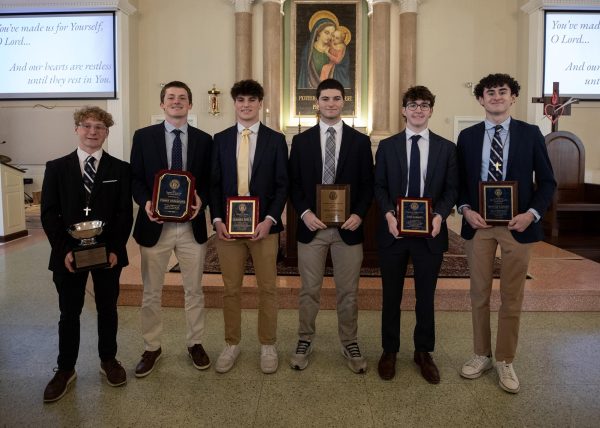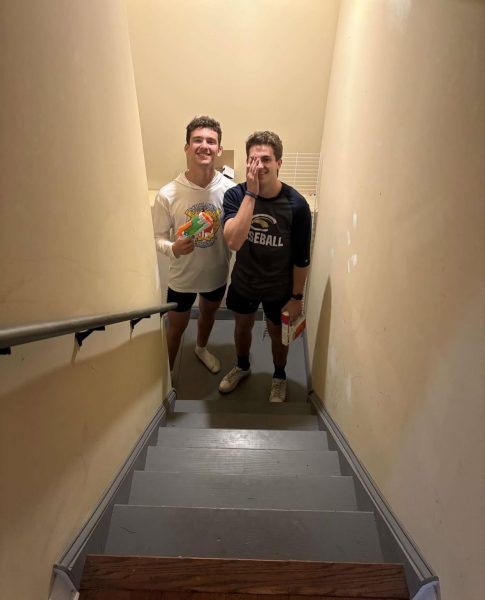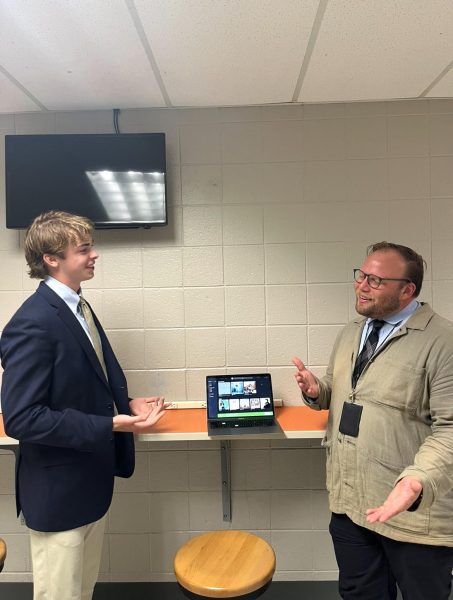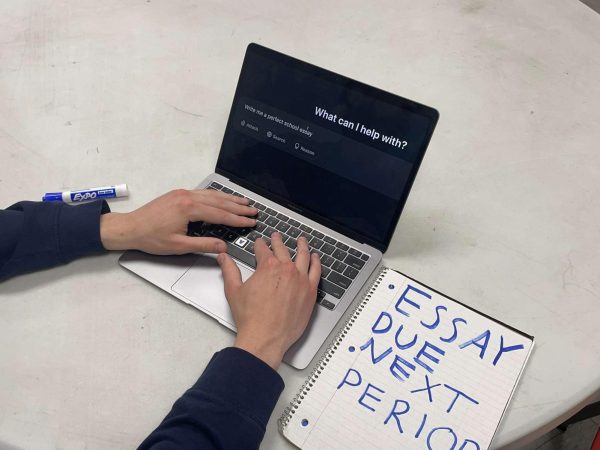Past, Present and Future: New Term, New Schedule
After completing term one, the Leadership team has decided to make some changes for term two and the rest of the 2020-2021 school year.
As the school year continues to progress, the Caritas Committee has taken time to assess how the year has been going, ultimately leading to changes for the Malvern community as a whole.
At the end of term one, the decision was made to change the academic schedule for the foreseeable future by moving a forty minute block of free time from the end of lunch, to the end of the day, all while keeping the four class implication.
“Father Reilly, Mr. Sillup and the Caritas Committee spoke a lot about, test and assess, right, this was a formula that was new for all of us opening a school in the middle of the pandemic. And there were no schools out there that had it figured out so to speak, cause no one had been through it yet,” Assistant Head of School for Student Leadership, Mr. Algeo said.
After going through one full term, both Mr. Sillup, Assistant Head of School for Academics and Agleo learned a lot and were able to make changes where they felt necessary. There were two points in particular that they thought were issues that needed fixing.
“We had that long space after eating, it was almost an hour. We worked with Mr. Sillup, myself, Mr. Boccuti, Mr. Carroll, we would go out to the turf and allow guys just to kind of get some energy out,” Algeo said.
After letting that time pan out to see how it might work, the faculty soon realized that it might not be the best option.
“What we learned in the test and assess was that we could do no contact tracing out in the field, that was the one space that there was just no way we could tell who was with you at what time,” Algeo said.
Another point of concern that Sillup found was mass crowding, which made contact tracing quite difficult to execute.
“So what was also happening is we were all dismissing at the same time. Essentially, you’d have all of your middle schoolers, many ninth grade, many tenth grade all descending upon the CSI, and the bridge for pickup. And again, it created this massive crowd, we got really concerned,” Sillup said.
These two issues of having too much unstructured free time after lunch, as well as the massive crowding during dismissal prompted the Caritas Committee to rethink their approach. After discussing their options, a new schedule was born.
The new schedule, which has been implemented, includes having a forty minute block after lunch now being moved to the end of the day, as well as having dismissal for the upper school and middle school staggered.
“So we [Caritas Committee] said well what if we did two things, what if what if we looked at the schedule and we shrunk lunch to be eaten in place. I think we have a shot,” Sillup said.
The fact that students now eat lunch in a particular place, rather than crowding together across campus, is in hope of keeping students as safe as possible, all while keeping contact tracing in mind.
“But, in the back half of the day, let’s also stagger dismissal,” Sillup says. “So our upper schoolers, you guys are done by 1:50, … the middle schoolers don’t walk over to that space, until about 2:20. And that 30 minutes really has alleviated the pressure of dismissal over there too,” Sillup further continued.
After making these changes in time to be put in place for the start of the second term, teachers and students alike both have had to adapt to this new schedule and both have their own opinions about this change.
Mr. Jason Sammartino, academy leader for the 11th grade, as well as an English teacher, really likes the layout and structure of the schedule that has been in place since the beginning of the school year.
“I’m a big fan of seeing my classes four days a week with a locked in schedule. I think makes things easy to plan, makes things, it gives that organization, and routine that I really look for in my day to day life,” Sammartino said.
As for the schedule change from term one to term two, with a new lunch layout and altered dismissal time, Sammartino feels that it is helpful for not only the teachers, but students as well.
“The lunch change as a teacher, if I’m teaching second and third, that is, I know that is a fast turnaround. But I also recognize that that open time afterwards was not exactly helpful for anybody, so I think that move was the right direction,” he says.
“I mean I like this schedule, I think, you know, no schedule is perfect, but I think we’re finding something that works,” Sammartino said.
As for Ms. Lauren Lesch, upper school math teacher, who has been teaching virtually, since the start of the school year, offers a different perspective about what the new schedule means for her.
“I like the new schedule. I do actually like having the time after two o’clock because I’ve been using that time to meet one-on-one with students; so for me it is nice you know, having classes run pretty close together and then having free time after,” Lesch said.
Now that classes are officially completed at 1:50pm, many teachers have been using that newly implemented time after school to meet with students.
“In the second term, I’ve been using it to meet with students, so it’s been nice to have time to schedule. Otherwise I’d be scheduling during study halls, but some kids don’t have study halls or we don’t have common free periods, So that common free time [at the end of the day] is really important to me,” Lesch said.
Now that the first term has come to a close and a new term begins, students, teachers and faculty reflect on how it went. What went well and what did not go well. The Leadership team also reflects on how the first term went, from their perspective and what their overall thoughts are about the structure of school during a pandemic.
In having school during a pandemic, what would be considered a success? Could it be having classes as close to how they’ve been in previous years, or could it simply be just having school open and functioning? These are points of interest that both the Leadership and faculty touched on about their thoughts of the first term.
“So one of the main goals was to open and open safely. And so in that, using that data, I would say yes, it’s been super successful,” Algeo said.
Similarly, Sillup said, “I’ll go from the standpoint of our goal for this year, is to be open, meaning on site as much as possible in any capacity possible; but to do so in a safe way, and engaging way, and supportive way for students. And I think in that spirit, it’s worked.”
The idea was to bring students back to campus gradually, rather than an “all at once,” approach. While cases have appeared throughout the community, Malvern, unlike a few other schools, has been able to stay open since the start of the school year.
“We’re not saying all look how great we are, but we certainly want to celebrate that [staying open] and take pride in that because there are a lot of people, including the students that put a lot of effort into making that happen,” Algeo explained.
Alego understands that the situation has been quite fluid and ever changing however, he feels confident in the community’s response to the changing environment and is grateful for the hard work, by all, which appears to be paying off.
“But when you say has this been successful, we look back at our main goal, can we open safely and stay open? And we have, so I would count that as being really successful? I’m proud of that. We did the best way we thought we could,” Algeo continued.
As Coronavirus cases rise across the country, many teachers, along with Algeo have expressed the importance of being vigilant with COVID protocols and stresses the significance of staying safe and keeping the case count to a minimum.
“So you have to be very careful of that [overconfidence]. So we still have to remain very vigilant, we can’t celebrate it too much; we can say hey, great job, awesome, but we got to keep this going,” Algeo said.
As for an academic perspective of how the first term went, Sillup explains his thoughts on how everyone has adapted to the schedule and what went into making some of these significant decisions as well as what went well and what did not.
Sillup said, “The idea is that we wanted to create focus and reduce stress, I think those two things are interlinked. So the idea of only caring for blocks allowed a student and a teacher … to focus on less things knowing that the environment around them, was going to be pretty, pretty tumultuous. It was changing all the time.”
There was a heavy focus on keeping it consistent when creating a schedule that would be applicable to both teachers and students. The Caritas Committee, knowing very well that many students have after school activities that take up large chunks of time needed to adapt to these changing times.
“If I’m a teacher, if I’m working with 30 or 40 kids is a lot different than working with 60, 70 or 80 students at a clip. And from a student’s perspective, you know, working with two, three or four classes seemed to be much more doable than six, seven or even eight blocks at a time. So I think that really helped, and that was positive,” Sillup continued.
While all these decisions were given an immense amount of thought and have been in the works for quite some time, students and teachers alike found some stumbles along the way.
“I think one of the challenges [of the first term] … was just connectivity, you know, seeing students meet with teachers is just hard I think everything has to be scheduled now, and that’s hard, like the informal [conversation], doesn’t happen often,” Sillup said.
“Connectivity,” as Sillup says fits in very well with Leschs’ thoughts about how her classes have been going so far. Since she has been teaching from home, Lesch has not had the opportunity to meet in person with her students.
“I would say the challenge is just not being physically with students and colleagues, you know, seeing your face virtually, I mean it’s great that we can see each other, but there’s just something different about being in person,” Lesch explained.
As for Sammartino, he offers his own thoughts about how the first term went and what he thinks were some positives and negatives.
“It was fast,” he said. You know, we’ve been calling these intensives, and I think that’s a good term for them,” Sammartino continued.
“This is an intense experience. For me, as an English teacher, you know, getting essays back quickly with feedback, you know, is a challenge, but I see that as, there’s a bigger importance for me now to get feedback quicker than there was in the past,” Sammartino said.
One big change to the school year that has affected all of those on campus was the implementation of Brotherhood Days. Spearheaded by Mr. Algeo and the Caritas Committee, these days were brought about to allow students the time to meet with teachers, have club meetings or even spend time with friends.
With these many new changes coming to the Malvern Community, many students have begun to voice their opinions, particularly about Brotherhood Days.
“Some positives, of course, have been like the camaraderie that’s been built, the time spent just being involved with obviously, physical activity, taking care of yourselves and just being with each other,” Algeo said.
Along with the positive feedback that has been received from Brotherhood Days, there has also been some negative feedback that has and will continue to be taken into consideration.
“Improvements, I’ve heard some feedback where some see it as less structured and like to have more structure with it, I totally understand that. And my only caution going into is trying not to be too prescriptive,” Algeo noted.
As the weather begins to get colder and we enter the winter months, being outside for Brotherhood Days begins to become a little more difficult and Algeo and the Leadership team have been planning for some adjustments that may potentially come in the future.
“We’re a little concerned and worried about January and February with weather. It’s hard for Intramurals, especially Mr. Gursky and his team to stand out there for over two hours. We have a couple proposals we’re messing around with a little bit. I know the academy leaders … are meeting with Mr. Sillup … to put together a few more prototypes about what brotherhood day could look like,” Algeo said.
With every new change that has come during the school year, the teachers have been affected a great deal. Many of them, who have been teaching for a long time, have had to completely rethink and rework how they would normally teach a class. For these reasons, both Algeo and Sillup are incredibly thankful for all that they do.
Algeo said, “I give the teachers an immense amount of credit,” while Sillup said, “I think they’ve been incredible.”
For some teachers, it can be especially difficult to create lesson plans for both virtual and online learning experiences as well as being able to adapt at a notices’ moment to the circumstances that are presented.
“So when we said to them, March 11, hey, you know, see you tomorrow, and then March 12, we’re like, okay, now we’re going all online; that’s a massive shift. And nobody panicked, they just did the best they could. We certainly gave them a lot of support, but they were just incredible,” Algeo noted.
Having to adapt to the new changes can be very difficult, but Algeo and Sillup are both in agreement that the teachers have been doing a fantastic job.
“I feel the same way about our faculty in terms of the time and energy they’ve invested to make their classes, come to life, amidst these conditions,” Sillup said.
Even Sammartino himself goes into detail about how he has had to adapt his classes to fit with the changes being made.
“Over the term as more students are coming on campus as I was learning my limitations in the classroom and how to do a hybrid model. I’ve found, I think, good ways to do the discussions that I like,” Sammartino said.
Along with the transitioning to a new term and adjusting to a new schedule, all of those on campus have been adjusting to the COVID-19 protocols which have been put in place for the safety of all students, faculty and staff.
“I got to give you guys credit, you’re doing, you’re doing better than I expected,” Sammartino said.
Though times have changed since his own time as a Malvern Prep student, Sammartino knows the Friar Brotherhood very well, as he himself is a graduate from Malvern.
“I knew the social distancing was going to be negligible, that’s just a very tough thing, especially you know I went to Malvern, I know how it goes. So that was something that I, you know, we still want to correct when we see it being over the top close, but I knew that would be an issue,” Sammartino said.
Generally speaking, the Leadership team as a whole is excited and pleased by the fact that Malvern has been able to stay open since the start of the year. While the classes and schedule are different than those in the past, the school administration has made it a priority to allow for students to receive a comprehensive education, on campus, in the most safe way possible.






